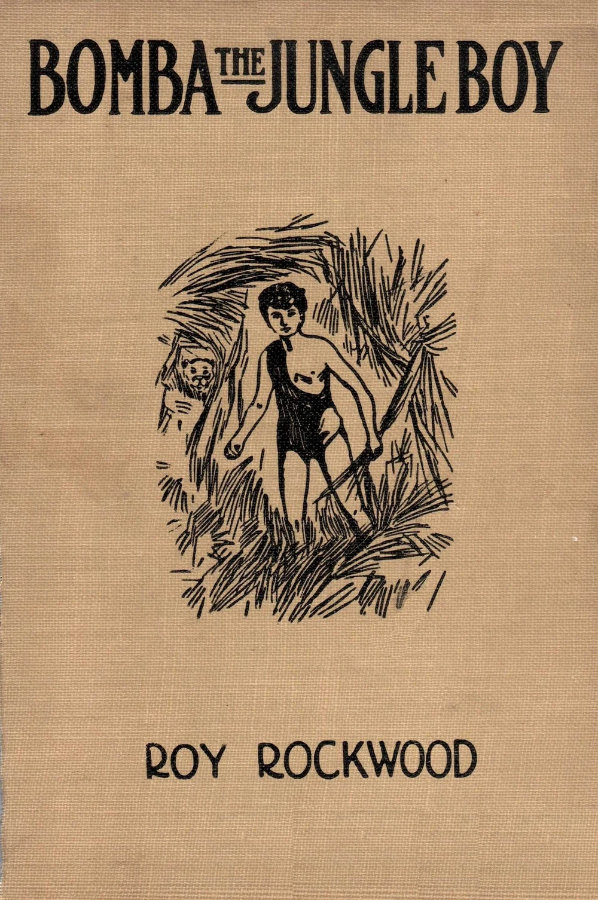Bomba the Jungle Boy is a series of American boys’ adventure books produced by the Stratemeyer Syndicate under the pseudonym Roy Rockwood. and published by Cupples and Leon in the first half of the 20th century, in imitation of the successful Tarzan series. Twenty books are in the series. The first 10 (published from 1926–1930) are set in South America, where Bomba, a white boy who grew up in the jungle, tries to discover his origin. The second set of 10 books (published from 1931–1938) shift the scene to Africa, where a slightly older Bomba has jungle adventures. The first editions all used the same cover illustration on their dust jackets; only the title would differ from book to book. A common theme of the Bomba books is stated in the first volume of the series, when Bomba concludes that: “The native’s souls were asleep. The white men’s souls were awake. And he was white!” Richard A. Lupoff, in his book Master of Adventure, a study of the works of Tarzan creator Edgar Rice Burroughs, describes the Bomba tales as more blatantly racist than the often-criticized Tarzan books. Note: As of January 1, 2025, only Bomba the Jungle Boy stories that were published before 1930 are public domain.
| Alias Bomba the Jungle Boy |
| Real Names/Alt Names Bomba |
| Characteristics Hero, Film Characters, Jungle Action, Literary Characters, Wold Newton Universe, Modernism Era, Juvenile, South American |
| Creators/Key Contributors John W. Duffield (pseudonym Roy Rockwood) |
| First Appearance Bomba the Jungle Boy (1926) |
| First Publisher Stratemeyer Syndicate, Cupples and Leon |
| Appearance List Novels: Bomba the Jungle Boy (1926); Bomba the Jungle Boy at the Moving Mountain (1926); Bomba the Jungle Boy at the Giant Cataract (1926); Bomba the Jungle Boy on Jaguar Island (1927); Bomba the Jungle Boy and the Abandoned City (1927); Bomba the Jungle Boy on Terror Trail (1928); Bomba the Jungle Boy in the Swamp of Death (1929); Bomba the Jungle Boy Among the Slaves (1929); Bomba the Jungle Boy on the Underground River (1930); Bomba the Jungle Boy and the Lost Explorers (1930); Bomba the Jungle Boy in a Strange Land (1931, Bomba’s first adventure in Africa); Bomba the Jungle Boy Among the Pygmies (1931); Bomba the Jungle Boy and the Cannibals (1932); Bomba the Jungle Boy and the Painted Hunters (1932); Bomba the Jungle Boy and the River Demons (1933); Bomba the Jungle Boy and the Hostile Chieftain (1934); Bomba the Jungle Boy Trapped by the Cyclone (1935); Bomba the Jungle Boy in the Land of Burning Lava (1936); Bomba the Jungle Boy in the Perilous Kingdom (1937); Bomba the Jungle Boy in the Steaming Grotto (1938). Film: Bomba, the Jungle Boy (1949), Bomba on Panther Island (1949), The Lost Volcano (1950), Bomba and the Hidden City (1950), The Lion Hunters (1951), Elephant Stampede (1952), African Treasure (1952), Bomba and the Jungle Girl (1952), Safari Drums (1953), The Golden Idol (1954), Killer Leopard (1954), Lord of the Jungle (1955). |
| Sample Read Bomba the Jungle Boy (1953 edition) [Web] |
| Description Bomba the Jungle Boy is a series of American boys’ adventure books produced by the Stratemeyer Syndicate under the pseudonym Roy Rockwood. and published by Cupples and Leon in the first half of the 20th century, in imitation of the successful Tarzan series. Twenty books are in the series. The first 10 (published from 1926–1930) are set in South America, where Bomba, a white boy who grew up in the jungle, tries to discover his origin. The second set of 10 books (published from 1931–1938) shift the scene to Africa, where a slightly older Bomba has jungle adventures. The first editions all used the same cover illustration on their dust jackets; only the title would differ from book to book. A common theme of the Bomba books is stated in the first volume of the series, when Bomba concludes that: “The native’s souls were asleep. The white men’s souls were awake. And he was white!” Richard A. Lupoff, in his book Master of Adventure, a study of the works of Tarzan creator Edgar Rice Burroughs, describes the Bomba tales as more blatantly racist than the often-criticized Tarzan books. Note: As of January 1, 2025, only Bomba the Jungle Boy stories that were published before 1930 are public domain. |
| Source Bomba the Jungle Boy – Wikipedia |


